Healthcare Leadership Report: Quality, Safety, and Patient Wellbeing
VerifiedAdded on 2022/09/16
|13
|2460
|28
Report
AI Summary
This report delves into the critical aspects of leadership in healthcare, with a primary focus on quality and patient safety. It begins by defining patient safety, differentiating it from general healthcare safety, and elucidating the role and objectives of risk management, including the tools employed by health professionals during risk analysis. The report then examines the concept of 'safety culture' in healthcare, discussing its measurement and the implications of a poor safety culture for both healthcare professionals and patients. Furthermore, it explores the distinctions between clinical governance and clinical leadership within the context of quality and safety, emphasizing the impact of professional communication on patient wellbeing. The report aims to provide a comprehensive overview of leadership's role in fostering a safe and high-quality healthcare environment.
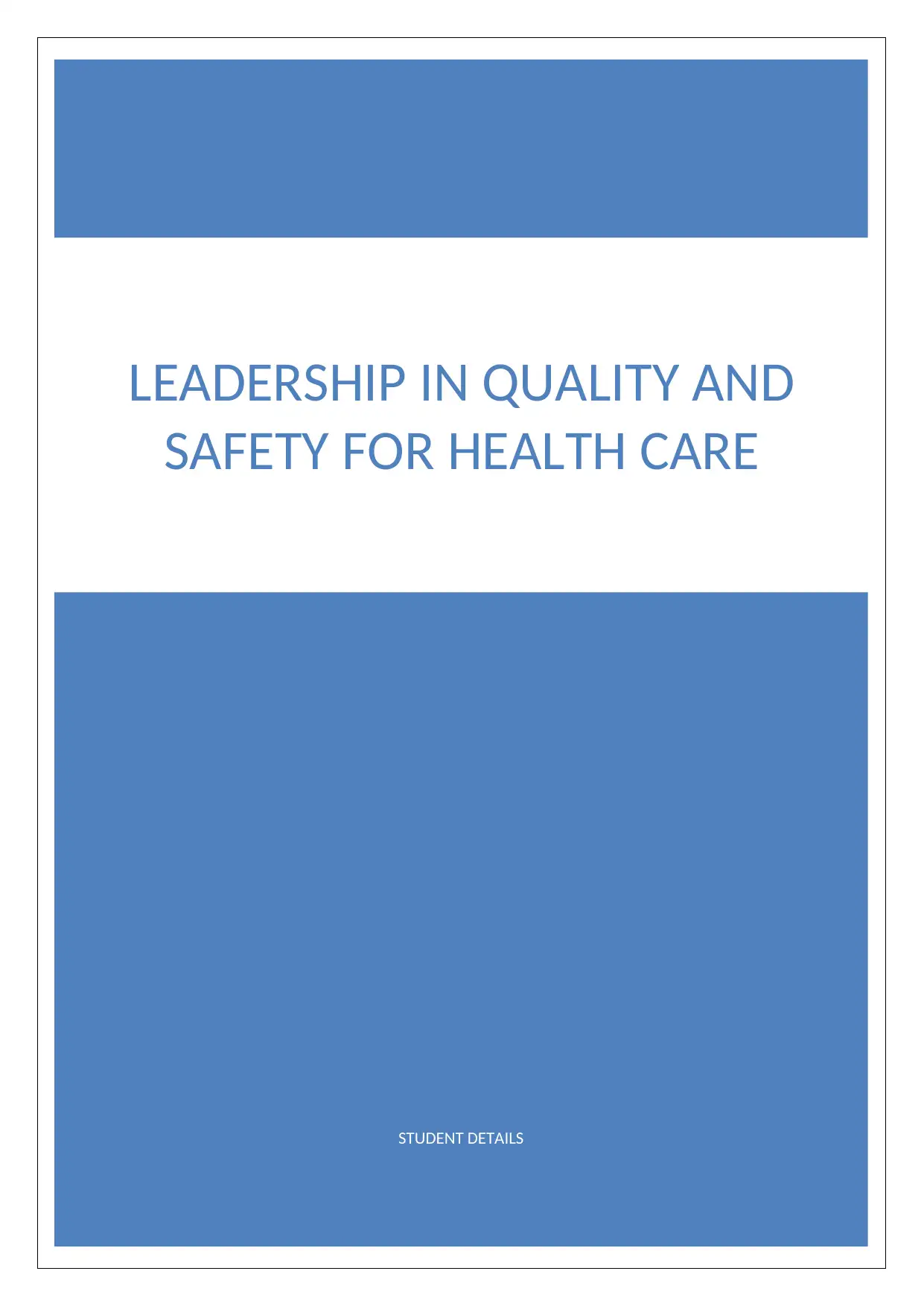
STUDENT DETAILS
LEADERSHIP IN QUALITY AND
SAFETY FOR HEALTH CARE
LEADERSHIP IN QUALITY AND
SAFETY FOR HEALTH CARE
Secure Best Marks with AI Grader
Need help grading? Try our AI Grader for instant feedback on your assignments.
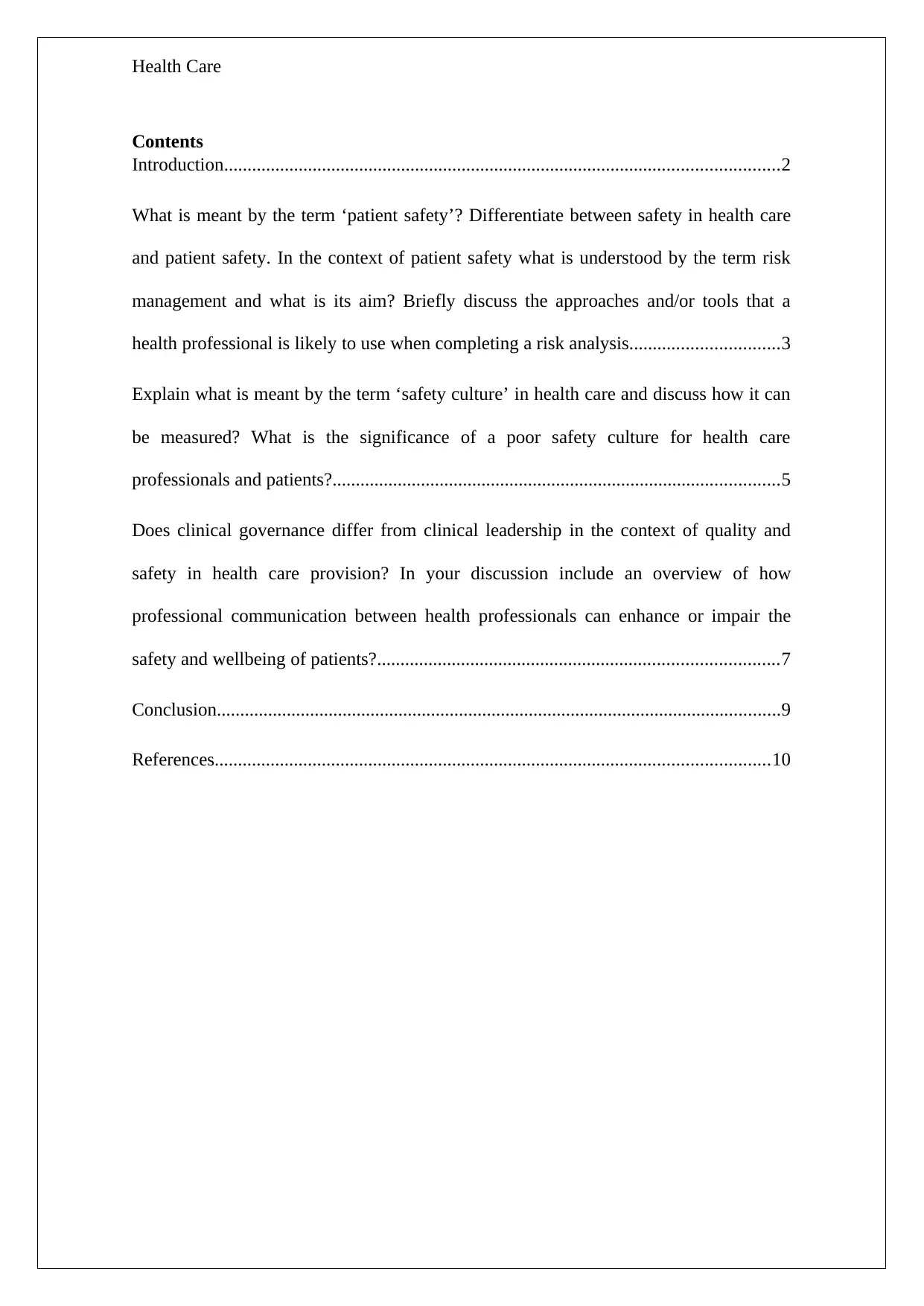
Health Care
Contents
Introduction.......................................................................................................................2
What is meant by the term ‘patient safety’? Differentiate between safety in health care
and patient safety. In the context of patient safety what is understood by the term risk
management and what is its aim? Briefly discuss the approaches and/or tools that a
health professional is likely to use when completing a risk analysis................................3
Explain what is meant by the term ‘safety culture’ in health care and discuss how it can
be measured? What is the significance of a poor safety culture for health care
professionals and patients?................................................................................................5
Does clinical governance differ from clinical leadership in the context of quality and
safety in health care provision? In your discussion include an overview of how
professional communication between health professionals can enhance or impair the
safety and wellbeing of patients?......................................................................................7
Conclusion.........................................................................................................................9
References.......................................................................................................................10
Contents
Introduction.......................................................................................................................2
What is meant by the term ‘patient safety’? Differentiate between safety in health care
and patient safety. In the context of patient safety what is understood by the term risk
management and what is its aim? Briefly discuss the approaches and/or tools that a
health professional is likely to use when completing a risk analysis................................3
Explain what is meant by the term ‘safety culture’ in health care and discuss how it can
be measured? What is the significance of a poor safety culture for health care
professionals and patients?................................................................................................5
Does clinical governance differ from clinical leadership in the context of quality and
safety in health care provision? In your discussion include an overview of how
professional communication between health professionals can enhance or impair the
safety and wellbeing of patients?......................................................................................7
Conclusion.........................................................................................................................9
References.......................................................................................................................10
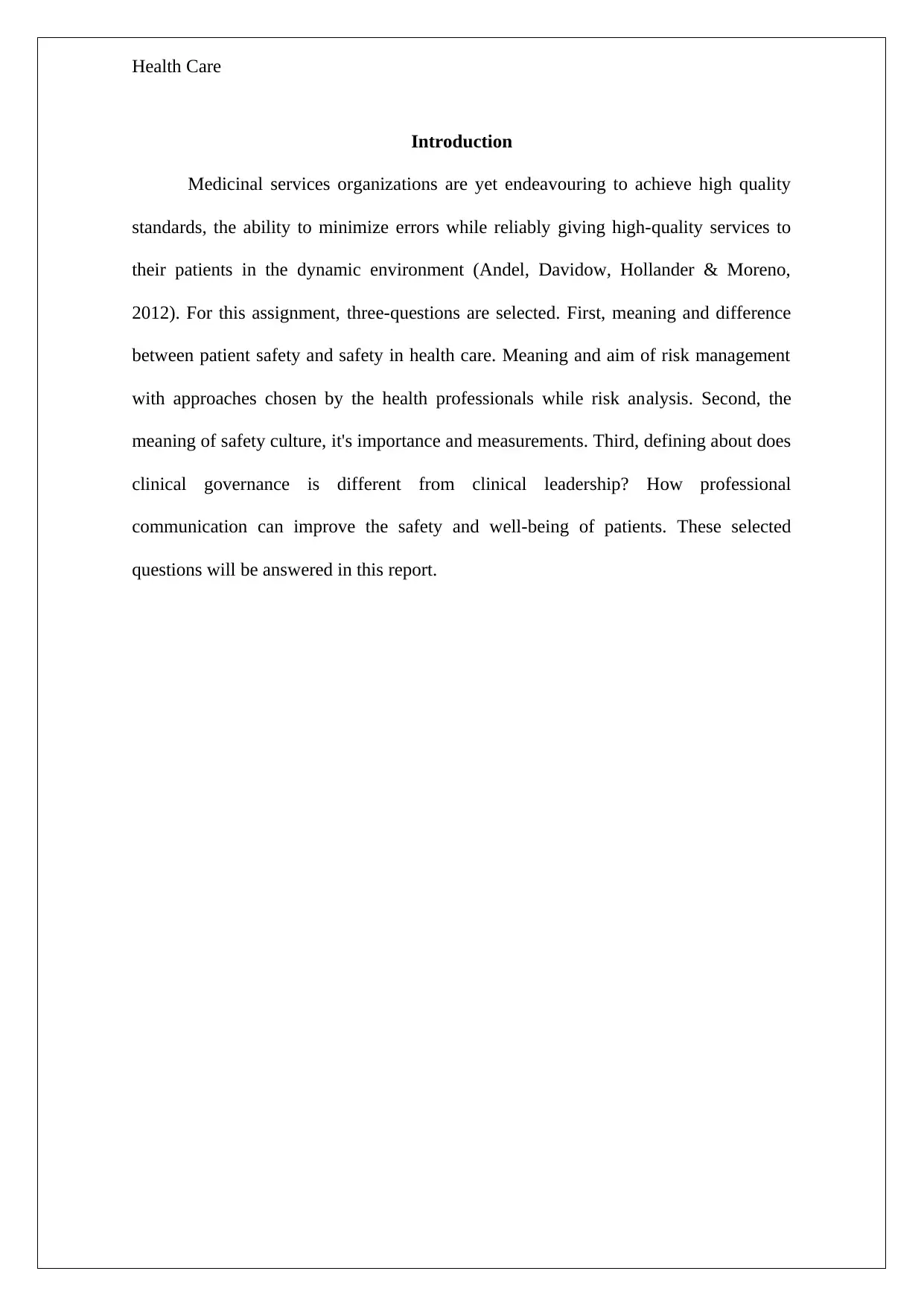
Health Care
Introduction
Medicinal services organizations are yet endeavouring to achieve high quality
standards, the ability to minimize errors while reliably giving high-quality services to
their patients in the dynamic environment (Andel, Davidow, Hollander & Moreno,
2012). For this assignment, three-questions are selected. First, meaning and difference
between patient safety and safety in health care. Meaning and aim of risk management
with approaches chosen by the health professionals while risk analysis. Second, the
meaning of safety culture, it's importance and measurements. Third, defining about does
clinical governance is different from clinical leadership? How professional
communication can improve the safety and well-being of patients. These selected
questions will be answered in this report.
Introduction
Medicinal services organizations are yet endeavouring to achieve high quality
standards, the ability to minimize errors while reliably giving high-quality services to
their patients in the dynamic environment (Andel, Davidow, Hollander & Moreno,
2012). For this assignment, three-questions are selected. First, meaning and difference
between patient safety and safety in health care. Meaning and aim of risk management
with approaches chosen by the health professionals while risk analysis. Second, the
meaning of safety culture, it's importance and measurements. Third, defining about does
clinical governance is different from clinical leadership? How professional
communication can improve the safety and well-being of patients. These selected
questions will be answered in this report.
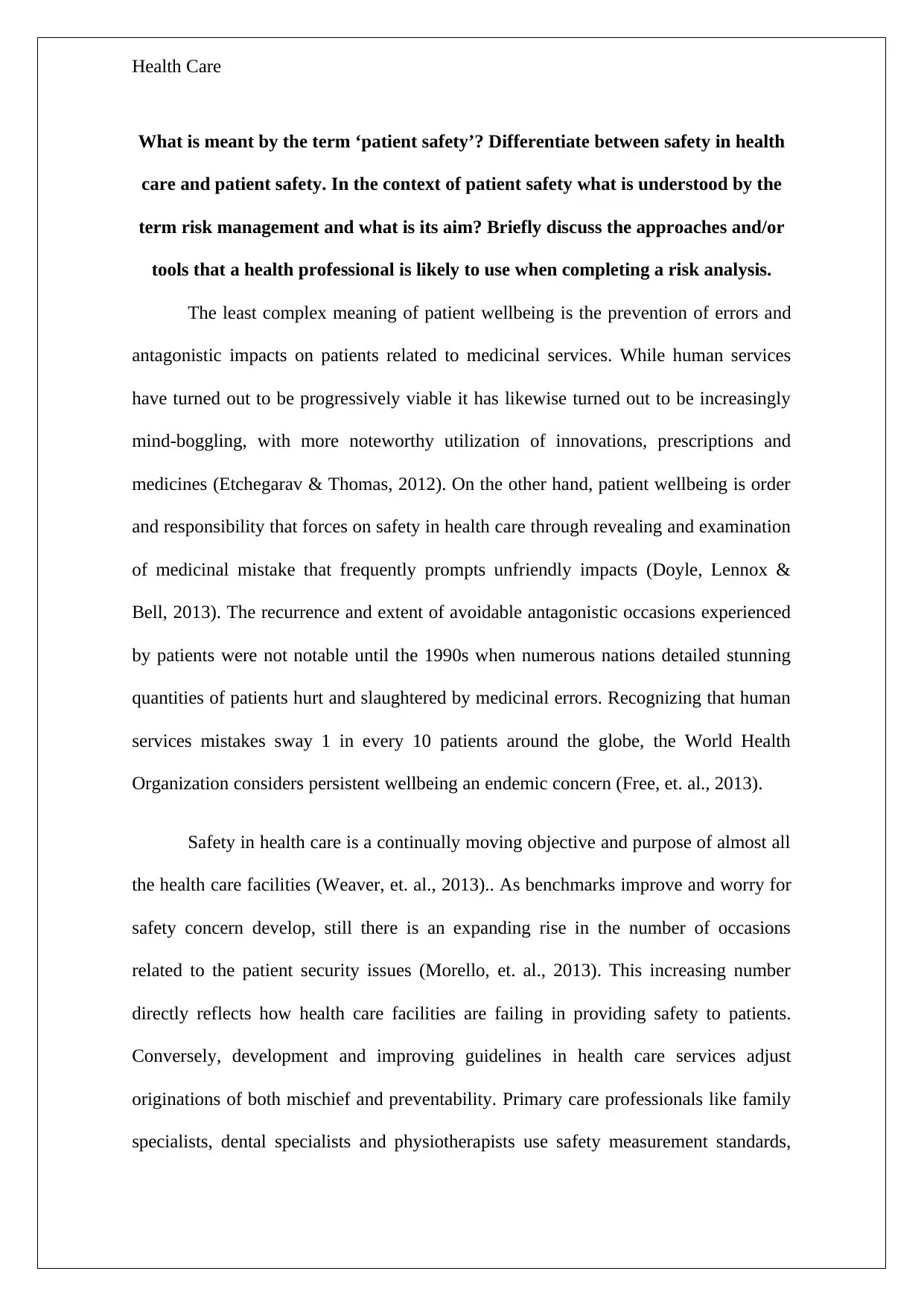
Health Care
What is meant by the term ‘patient safety’? Differentiate between safety in health
care and patient safety. In the context of patient safety what is understood by the
term risk management and what is its aim? Briefly discuss the approaches and/or
tools that a health professional is likely to use when completing a risk analysis.
The least complex meaning of patient wellbeing is the prevention of errors and
antagonistic impacts on patients related to medicinal services. While human services
have turned out to be progressively viable it has likewise turned out to be increasingly
mind-boggling, with more noteworthy utilization of innovations, prescriptions and
medicines (Etchegarav & Thomas, 2012). On the other hand, patient wellbeing is order
and responsibility that forces on safety in health care through revealing and examination
of medicinal mistake that frequently prompts unfriendly impacts (Doyle, Lennox &
Bell, 2013). The recurrence and extent of avoidable antagonistic occasions experienced
by patients were not notable until the 1990s when numerous nations detailed stunning
quantities of patients hurt and slaughtered by medicinal errors. Recognizing that human
services mistakes sway 1 in every 10 patients around the globe, the World Health
Organization considers persistent wellbeing an endemic concern (Free, et. al., 2013).
Safety in health care is a continually moving objective and purpose of almost all
the health care facilities (Weaver, et. al., 2013).. As benchmarks improve and worry for
safety concern develop, still there is an expanding rise in the number of occasions
related to the patient security issues (Morello, et. al., 2013). This increasing number
directly reflects how health care facilities are failing in providing safety to patients.
Conversely, development and improving guidelines in health care services adjust
originations of both mischief and preventability. Primary care professionals like family
specialists, dental specialists and physiotherapists use safety measurement standards,
What is meant by the term ‘patient safety’? Differentiate between safety in health
care and patient safety. In the context of patient safety what is understood by the
term risk management and what is its aim? Briefly discuss the approaches and/or
tools that a health professional is likely to use when completing a risk analysis.
The least complex meaning of patient wellbeing is the prevention of errors and
antagonistic impacts on patients related to medicinal services. While human services
have turned out to be progressively viable it has likewise turned out to be increasingly
mind-boggling, with more noteworthy utilization of innovations, prescriptions and
medicines (Etchegarav & Thomas, 2012). On the other hand, patient wellbeing is order
and responsibility that forces on safety in health care through revealing and examination
of medicinal mistake that frequently prompts unfriendly impacts (Doyle, Lennox &
Bell, 2013). The recurrence and extent of avoidable antagonistic occasions experienced
by patients were not notable until the 1990s when numerous nations detailed stunning
quantities of patients hurt and slaughtered by medicinal errors. Recognizing that human
services mistakes sway 1 in every 10 patients around the globe, the World Health
Organization considers persistent wellbeing an endemic concern (Free, et. al., 2013).
Safety in health care is a continually moving objective and purpose of almost all
the health care facilities (Weaver, et. al., 2013).. As benchmarks improve and worry for
safety concern develop, still there is an expanding rise in the number of occasions
related to the patient security issues (Morello, et. al., 2013). This increasing number
directly reflects how health care facilities are failing in providing safety to patients.
Conversely, development and improving guidelines in health care services adjust
originations of both mischief and preventability. Primary care professionals like family
specialists, dental specialists and physiotherapists use safety measurement standards,
Secure Best Marks with AI Grader
Need help grading? Try our AI Grader for instant feedback on your assignments.
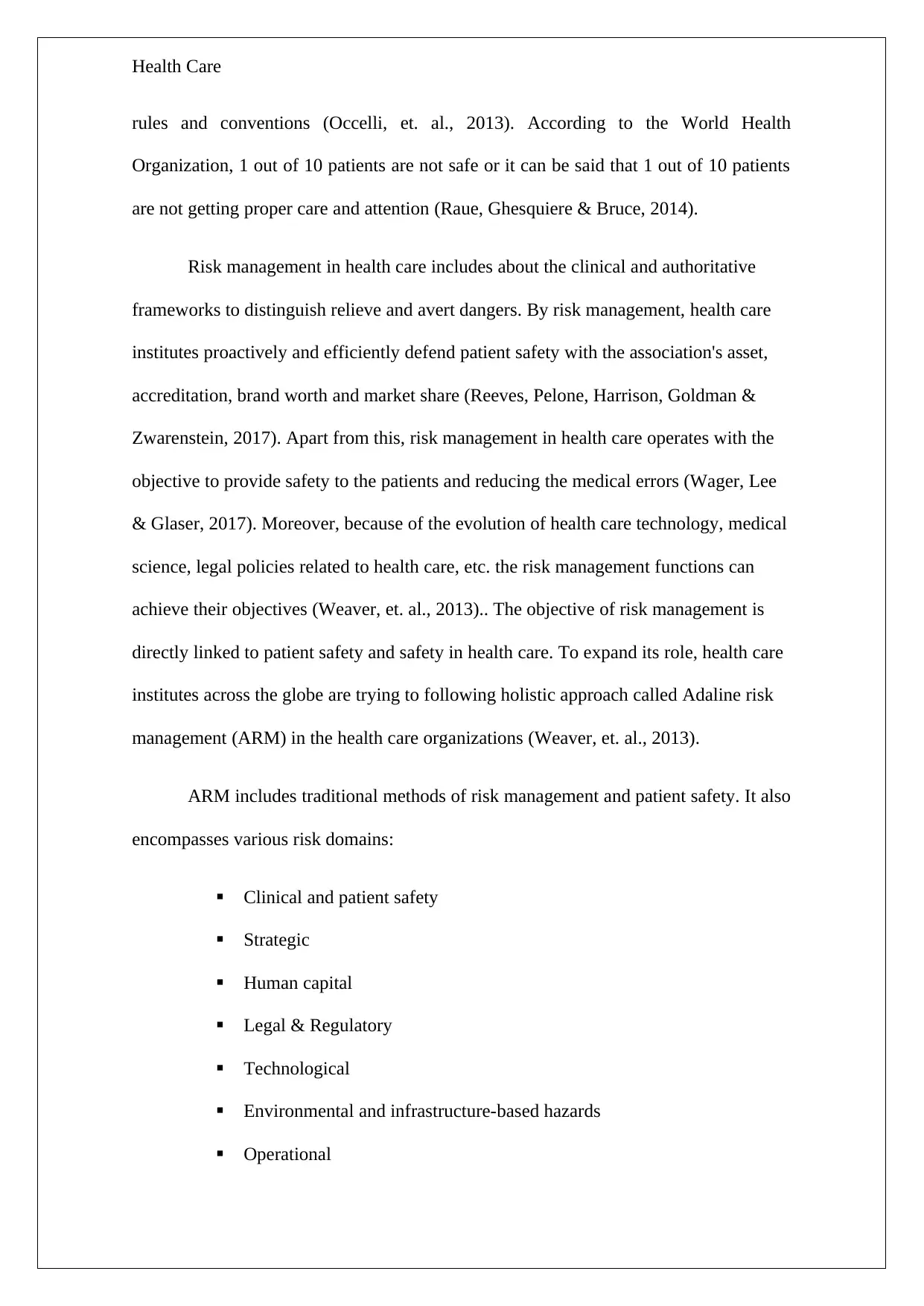
Health Care
rules and conventions (Occelli, et. al., 2013). According to the World Health
Organization, 1 out of 10 patients are not safe or it can be said that 1 out of 10 patients
are not getting proper care and attention (Raue, Ghesquiere & Bruce, 2014).
Risk management in health care includes about the clinical and authoritative
frameworks to distinguish relieve and avert dangers. By risk management, health care
institutes proactively and efficiently defend patient safety with the association's asset,
accreditation, brand worth and market share (Reeves, Pelone, Harrison, Goldman &
Zwarenstein, 2017). Apart from this, risk management in health care operates with the
objective to provide safety to the patients and reducing the medical errors (Wager, Lee
& Glaser, 2017). Moreover, because of the evolution of health care technology, medical
science, legal policies related to health care, etc. the risk management functions can
achieve their objectives (Weaver, et. al., 2013).. The objective of risk management is
directly linked to patient safety and safety in health care. To expand its role, health care
institutes across the globe are trying to following holistic approach called Adaline risk
management (ARM) in the health care organizations (Weaver, et. al., 2013).
ARM includes traditional methods of risk management and patient safety. It also
encompasses various risk domains:
Clinical and patient safety
Strategic
Human capital
Legal & Regulatory
Technological
Environmental and infrastructure-based hazards
Operational
rules and conventions (Occelli, et. al., 2013). According to the World Health
Organization, 1 out of 10 patients are not safe or it can be said that 1 out of 10 patients
are not getting proper care and attention (Raue, Ghesquiere & Bruce, 2014).
Risk management in health care includes about the clinical and authoritative
frameworks to distinguish relieve and avert dangers. By risk management, health care
institutes proactively and efficiently defend patient safety with the association's asset,
accreditation, brand worth and market share (Reeves, Pelone, Harrison, Goldman &
Zwarenstein, 2017). Apart from this, risk management in health care operates with the
objective to provide safety to the patients and reducing the medical errors (Wager, Lee
& Glaser, 2017). Moreover, because of the evolution of health care technology, medical
science, legal policies related to health care, etc. the risk management functions can
achieve their objectives (Weaver, et. al., 2013).. The objective of risk management is
directly linked to patient safety and safety in health care. To expand its role, health care
institutes across the globe are trying to following holistic approach called Adaline risk
management (ARM) in the health care organizations (Weaver, et. al., 2013).
ARM includes traditional methods of risk management and patient safety. It also
encompasses various risk domains:
Clinical and patient safety
Strategic
Human capital
Legal & Regulatory
Technological
Environmental and infrastructure-based hazards
Operational
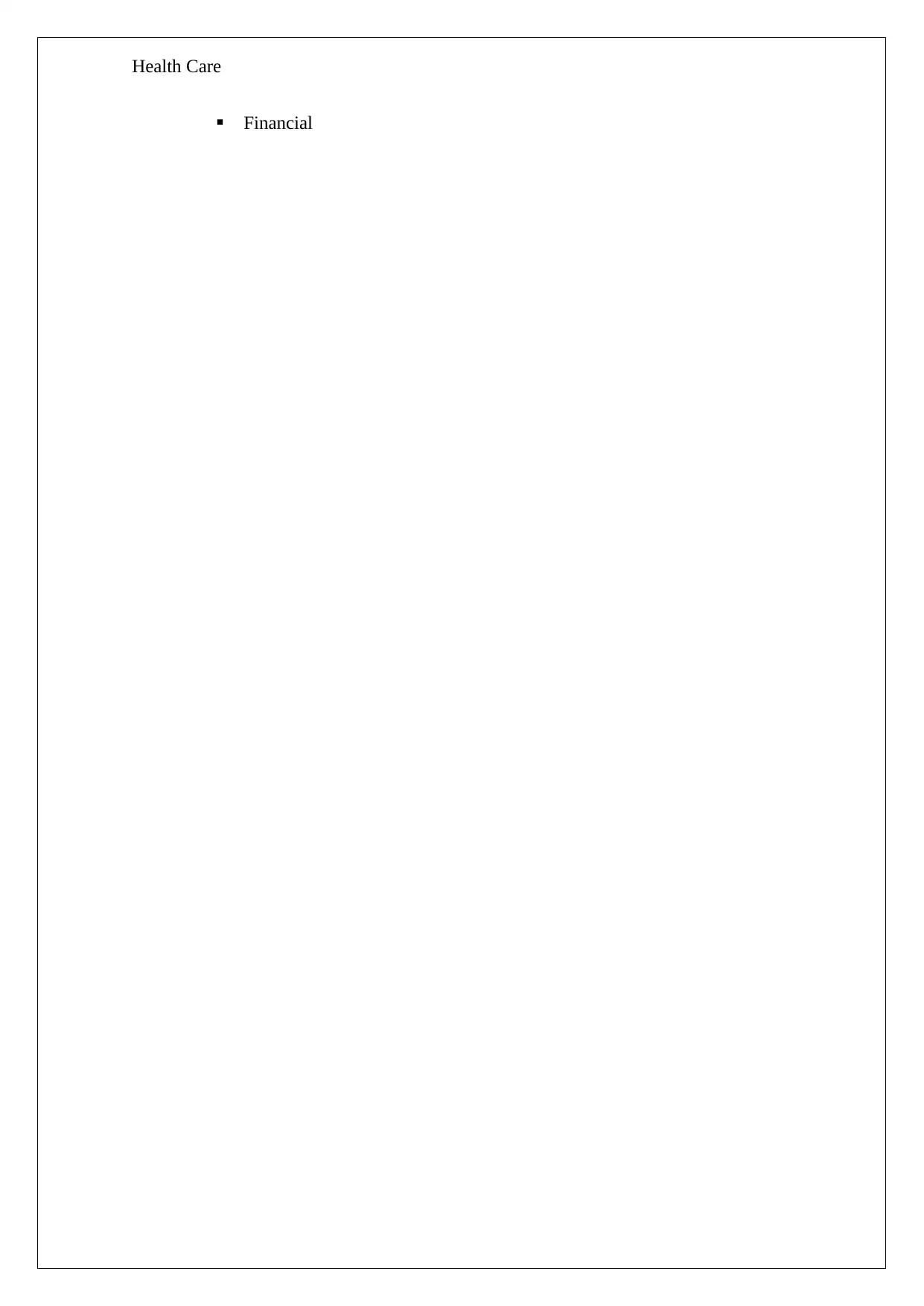
Health Care
Financial
Financial
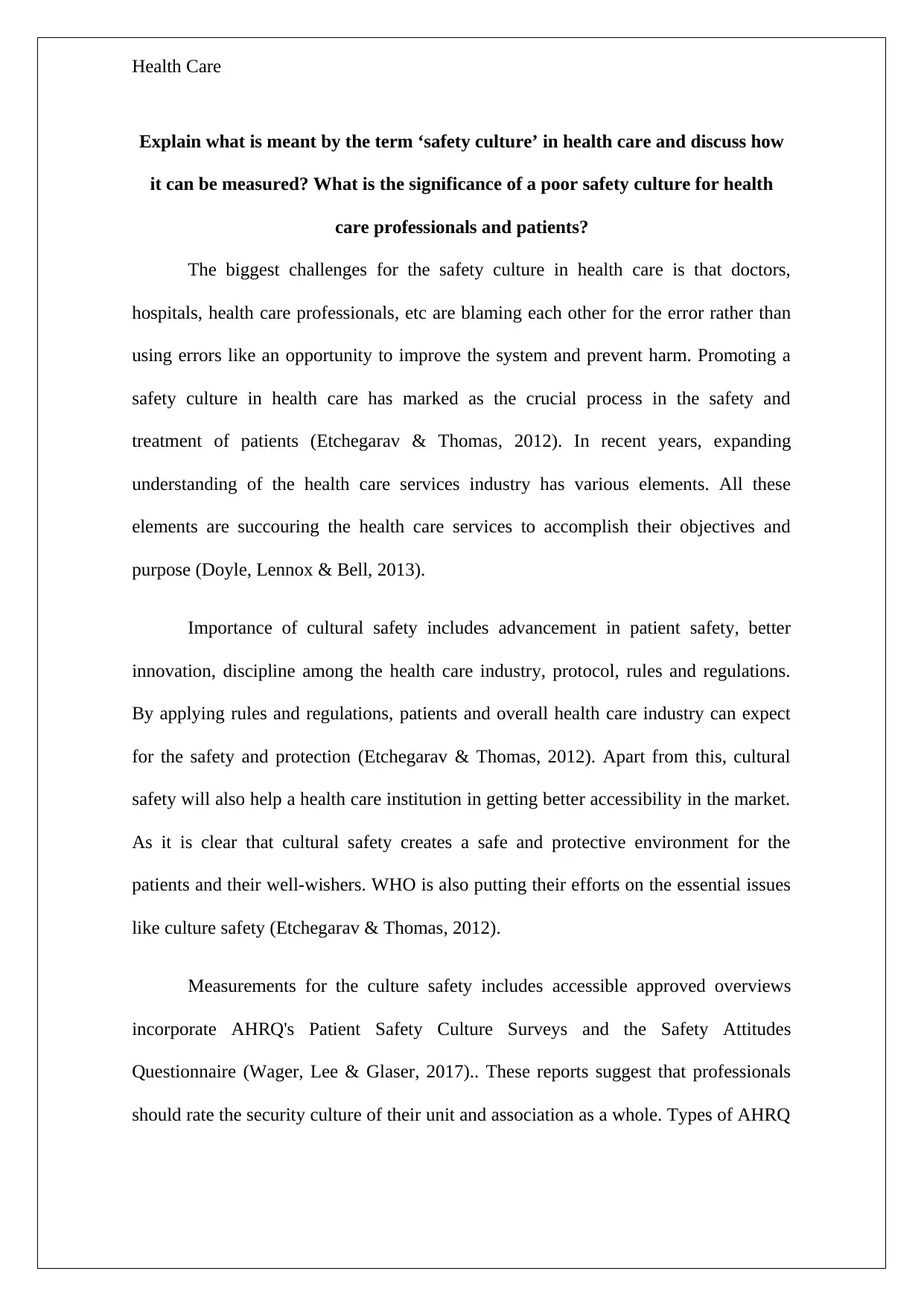
Health Care
Explain what is meant by the term ‘safety culture’ in health care and discuss how
it can be measured? What is the significance of a poor safety culture for health
care professionals and patients?
The biggest challenges for the safety culture in health care is that doctors,
hospitals, health care professionals, etc are blaming each other for the error rather than
using errors like an opportunity to improve the system and prevent harm. Promoting a
safety culture in health care has marked as the crucial process in the safety and
treatment of patients (Etchegarav & Thomas, 2012). In recent years, expanding
understanding of the health care services industry has various elements. All these
elements are succouring the health care services to accomplish their objectives and
purpose (Doyle, Lennox & Bell, 2013).
Importance of cultural safety includes advancement in patient safety, better
innovation, discipline among the health care industry, protocol, rules and regulations.
By applying rules and regulations, patients and overall health care industry can expect
for the safety and protection (Etchegarav & Thomas, 2012). Apart from this, cultural
safety will also help a health care institution in getting better accessibility in the market.
As it is clear that cultural safety creates a safe and protective environment for the
patients and their well-wishers. WHO is also putting their efforts on the essential issues
like culture safety (Etchegarav & Thomas, 2012).
Measurements for the culture safety includes accessible approved overviews
incorporate AHRQ's Patient Safety Culture Surveys and the Safety Attitudes
Questionnaire (Wager, Lee & Glaser, 2017).. These reports suggest that professionals
should rate the security culture of their unit and association as a whole. Types of AHRQ
Explain what is meant by the term ‘safety culture’ in health care and discuss how
it can be measured? What is the significance of a poor safety culture for health
care professionals and patients?
The biggest challenges for the safety culture in health care is that doctors,
hospitals, health care professionals, etc are blaming each other for the error rather than
using errors like an opportunity to improve the system and prevent harm. Promoting a
safety culture in health care has marked as the crucial process in the safety and
treatment of patients (Etchegarav & Thomas, 2012). In recent years, expanding
understanding of the health care services industry has various elements. All these
elements are succouring the health care services to accomplish their objectives and
purpose (Doyle, Lennox & Bell, 2013).
Importance of cultural safety includes advancement in patient safety, better
innovation, discipline among the health care industry, protocol, rules and regulations.
By applying rules and regulations, patients and overall health care industry can expect
for the safety and protection (Etchegarav & Thomas, 2012). Apart from this, cultural
safety will also help a health care institution in getting better accessibility in the market.
As it is clear that cultural safety creates a safe and protective environment for the
patients and their well-wishers. WHO is also putting their efforts on the essential issues
like culture safety (Etchegarav & Thomas, 2012).
Measurements for the culture safety includes accessible approved overviews
incorporate AHRQ's Patient Safety Culture Surveys and the Safety Attitudes
Questionnaire (Wager, Lee & Glaser, 2017).. These reports suggest that professionals
should rate the security culture of their unit and association as a whole. Types of AHRQ
Paraphrase This Document
Need a fresh take? Get an instant paraphrase of this document with our AI Paraphraser
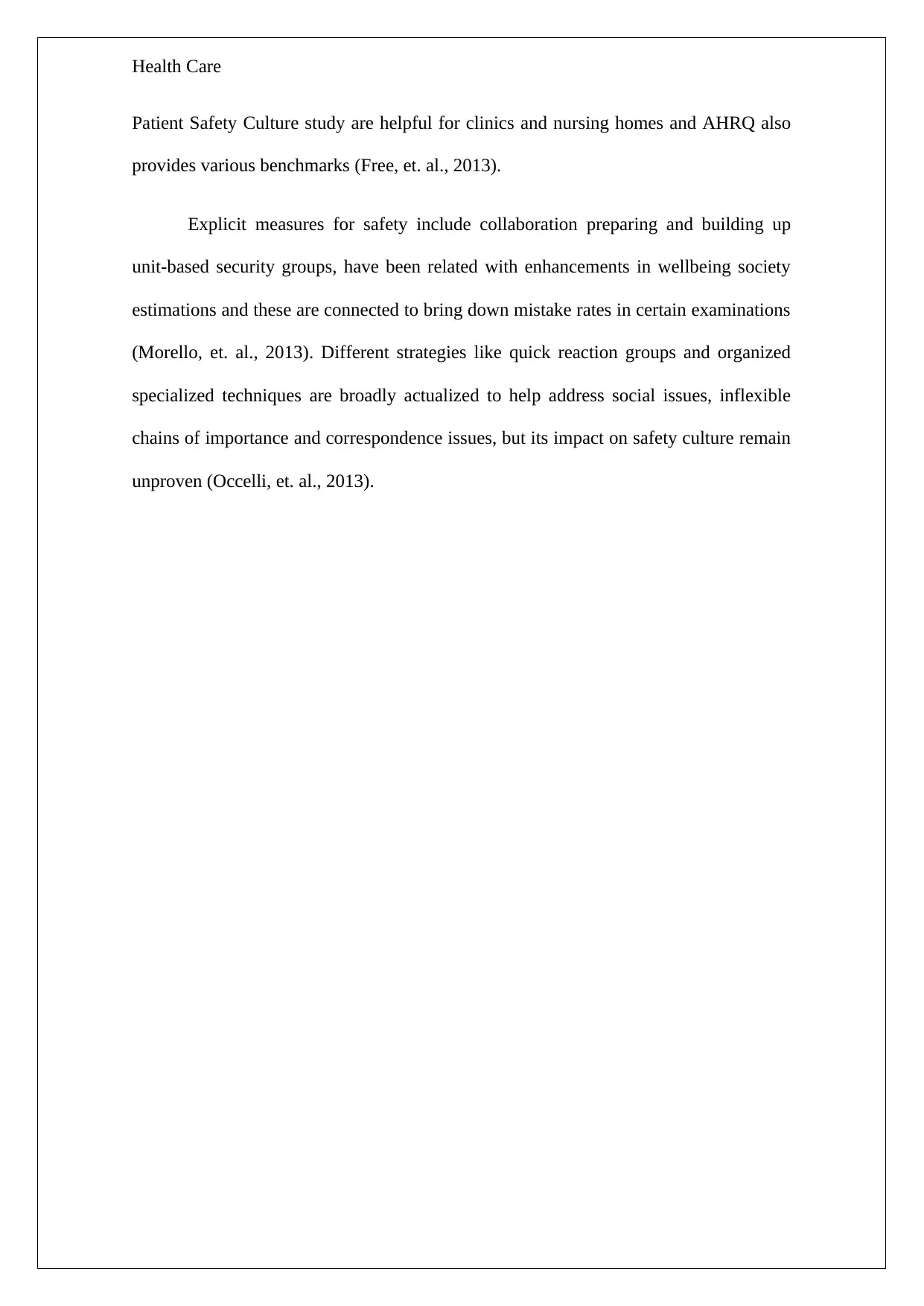
Health Care
Patient Safety Culture study are helpful for clinics and nursing homes and AHRQ also
provides various benchmarks (Free, et. al., 2013).
Explicit measures for safety include collaboration preparing and building up
unit-based security groups, have been related with enhancements in wellbeing society
estimations and these are connected to bring down mistake rates in certain examinations
(Morello, et. al., 2013). Different strategies like quick reaction groups and organized
specialized techniques are broadly actualized to help address social issues, inflexible
chains of importance and correspondence issues, but its impact on safety culture remain
unproven (Occelli, et. al., 2013).
Patient Safety Culture study are helpful for clinics and nursing homes and AHRQ also
provides various benchmarks (Free, et. al., 2013).
Explicit measures for safety include collaboration preparing and building up
unit-based security groups, have been related with enhancements in wellbeing society
estimations and these are connected to bring down mistake rates in certain examinations
(Morello, et. al., 2013). Different strategies like quick reaction groups and organized
specialized techniques are broadly actualized to help address social issues, inflexible
chains of importance and correspondence issues, but its impact on safety culture remain
unproven (Occelli, et. al., 2013).
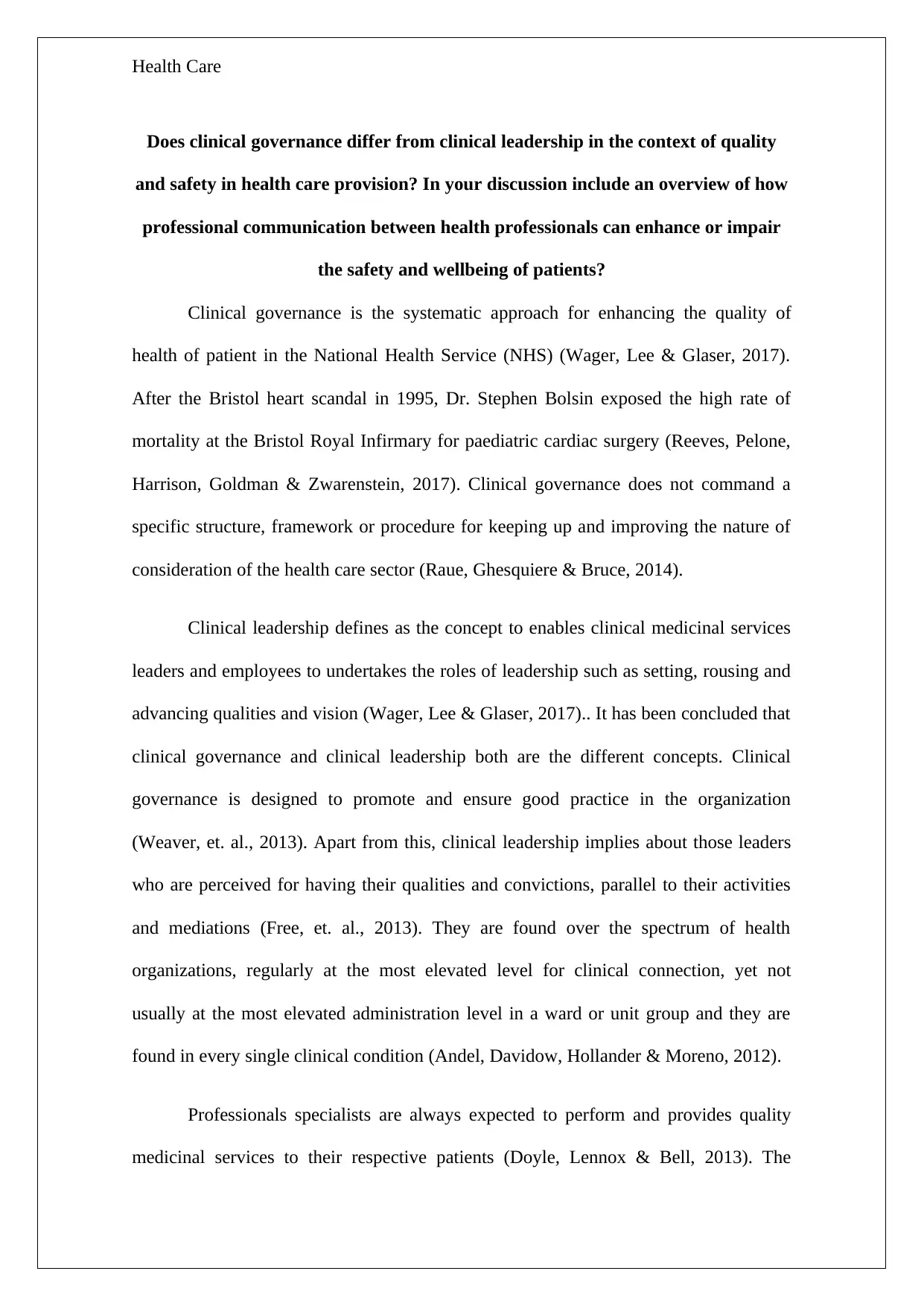
Health Care
Does clinical governance differ from clinical leadership in the context of quality
and safety in health care provision? In your discussion include an overview of how
professional communication between health professionals can enhance or impair
the safety and wellbeing of patients?
Clinical governance is the systematic approach for enhancing the quality of
health of patient in the National Health Service (NHS) (Wager, Lee & Glaser, 2017).
After the Bristol heart scandal in 1995, Dr. Stephen Bolsin exposed the high rate of
mortality at the Bristol Royal Infirmary for paediatric cardiac surgery (Reeves, Pelone,
Harrison, Goldman & Zwarenstein, 2017). Clinical governance does not command a
specific structure, framework or procedure for keeping up and improving the nature of
consideration of the health care sector (Raue, Ghesquiere & Bruce, 2014).
Clinical leadership defines as the concept to enables clinical medicinal services
leaders and employees to undertakes the roles of leadership such as setting, rousing and
advancing qualities and vision (Wager, Lee & Glaser, 2017).. It has been concluded that
clinical governance and clinical leadership both are the different concepts. Clinical
governance is designed to promote and ensure good practice in the organization
(Weaver, et. al., 2013). Apart from this, clinical leadership implies about those leaders
who are perceived for having their qualities and convictions, parallel to their activities
and mediations (Free, et. al., 2013). They are found over the spectrum of health
organizations, regularly at the most elevated level for clinical connection, yet not
usually at the most elevated administration level in a ward or unit group and they are
found in every single clinical condition (Andel, Davidow, Hollander & Moreno, 2012).
Professionals specialists are always expected to perform and provides quality
medicinal services to their respective patients (Doyle, Lennox & Bell, 2013). The
Does clinical governance differ from clinical leadership in the context of quality
and safety in health care provision? In your discussion include an overview of how
professional communication between health professionals can enhance or impair
the safety and wellbeing of patients?
Clinical governance is the systematic approach for enhancing the quality of
health of patient in the National Health Service (NHS) (Wager, Lee & Glaser, 2017).
After the Bristol heart scandal in 1995, Dr. Stephen Bolsin exposed the high rate of
mortality at the Bristol Royal Infirmary for paediatric cardiac surgery (Reeves, Pelone,
Harrison, Goldman & Zwarenstein, 2017). Clinical governance does not command a
specific structure, framework or procedure for keeping up and improving the nature of
consideration of the health care sector (Raue, Ghesquiere & Bruce, 2014).
Clinical leadership defines as the concept to enables clinical medicinal services
leaders and employees to undertakes the roles of leadership such as setting, rousing and
advancing qualities and vision (Wager, Lee & Glaser, 2017).. It has been concluded that
clinical governance and clinical leadership both are the different concepts. Clinical
governance is designed to promote and ensure good practice in the organization
(Weaver, et. al., 2013). Apart from this, clinical leadership implies about those leaders
who are perceived for having their qualities and convictions, parallel to their activities
and mediations (Free, et. al., 2013). They are found over the spectrum of health
organizations, regularly at the most elevated level for clinical connection, yet not
usually at the most elevated administration level in a ward or unit group and they are
found in every single clinical condition (Andel, Davidow, Hollander & Moreno, 2012).
Professionals specialists are always expected to perform and provides quality
medicinal services to their respective patients (Doyle, Lennox & Bell, 2013). The
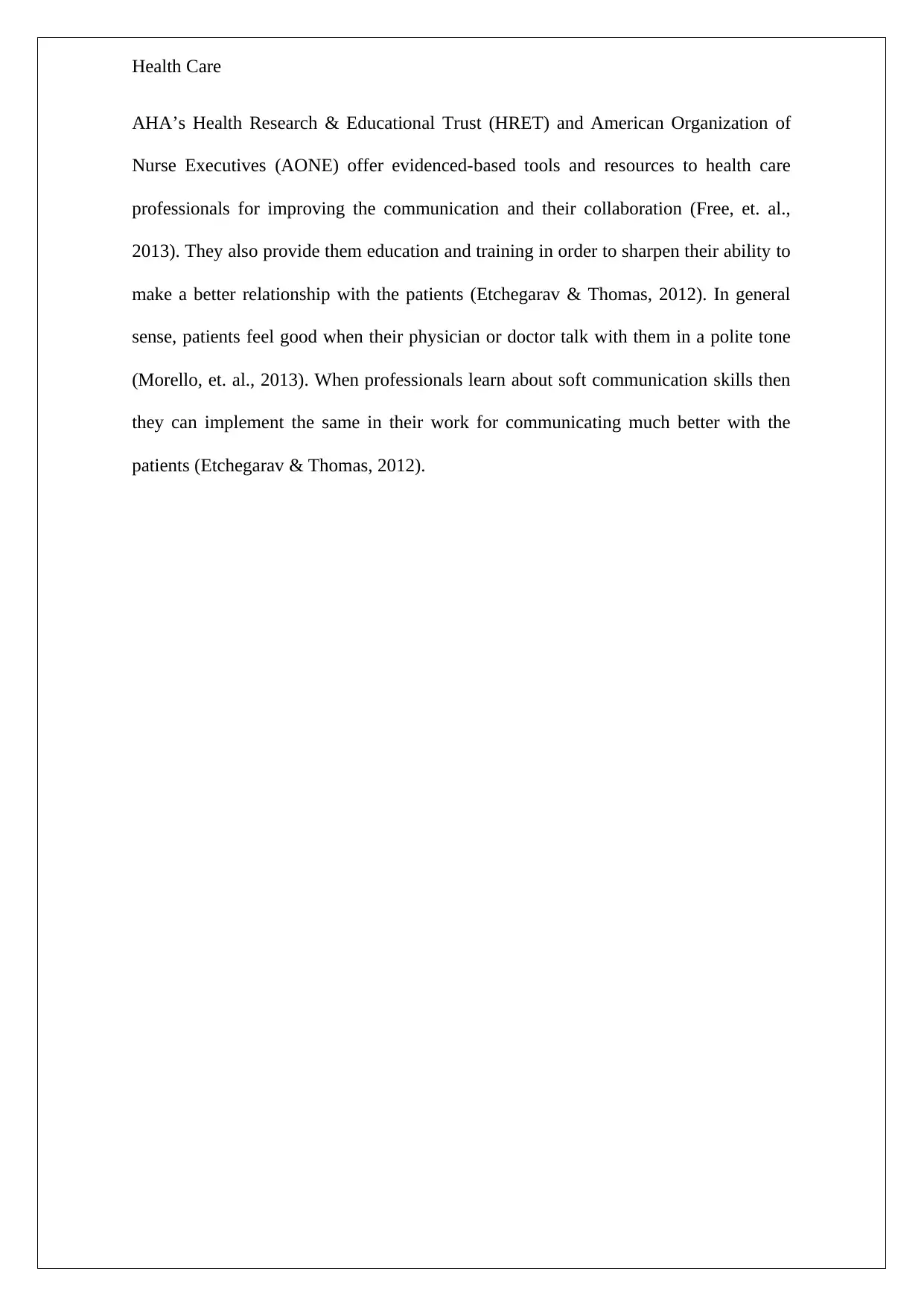
Health Care
AHA’s Health Research & Educational Trust (HRET) and American Organization of
Nurse Executives (AONE) offer evidenced-based tools and resources to health care
professionals for improving the communication and their collaboration (Free, et. al.,
2013). They also provide them education and training in order to sharpen their ability to
make a better relationship with the patients (Etchegarav & Thomas, 2012). In general
sense, patients feel good when their physician or doctor talk with them in a polite tone
(Morello, et. al., 2013). When professionals learn about soft communication skills then
they can implement the same in their work for communicating much better with the
patients (Etchegarav & Thomas, 2012).
AHA’s Health Research & Educational Trust (HRET) and American Organization of
Nurse Executives (AONE) offer evidenced-based tools and resources to health care
professionals for improving the communication and their collaboration (Free, et. al.,
2013). They also provide them education and training in order to sharpen their ability to
make a better relationship with the patients (Etchegarav & Thomas, 2012). In general
sense, patients feel good when their physician or doctor talk with them in a polite tone
(Morello, et. al., 2013). When professionals learn about soft communication skills then
they can implement the same in their work for communicating much better with the
patients (Etchegarav & Thomas, 2012).
Secure Best Marks with AI Grader
Need help grading? Try our AI Grader for instant feedback on your assignments.
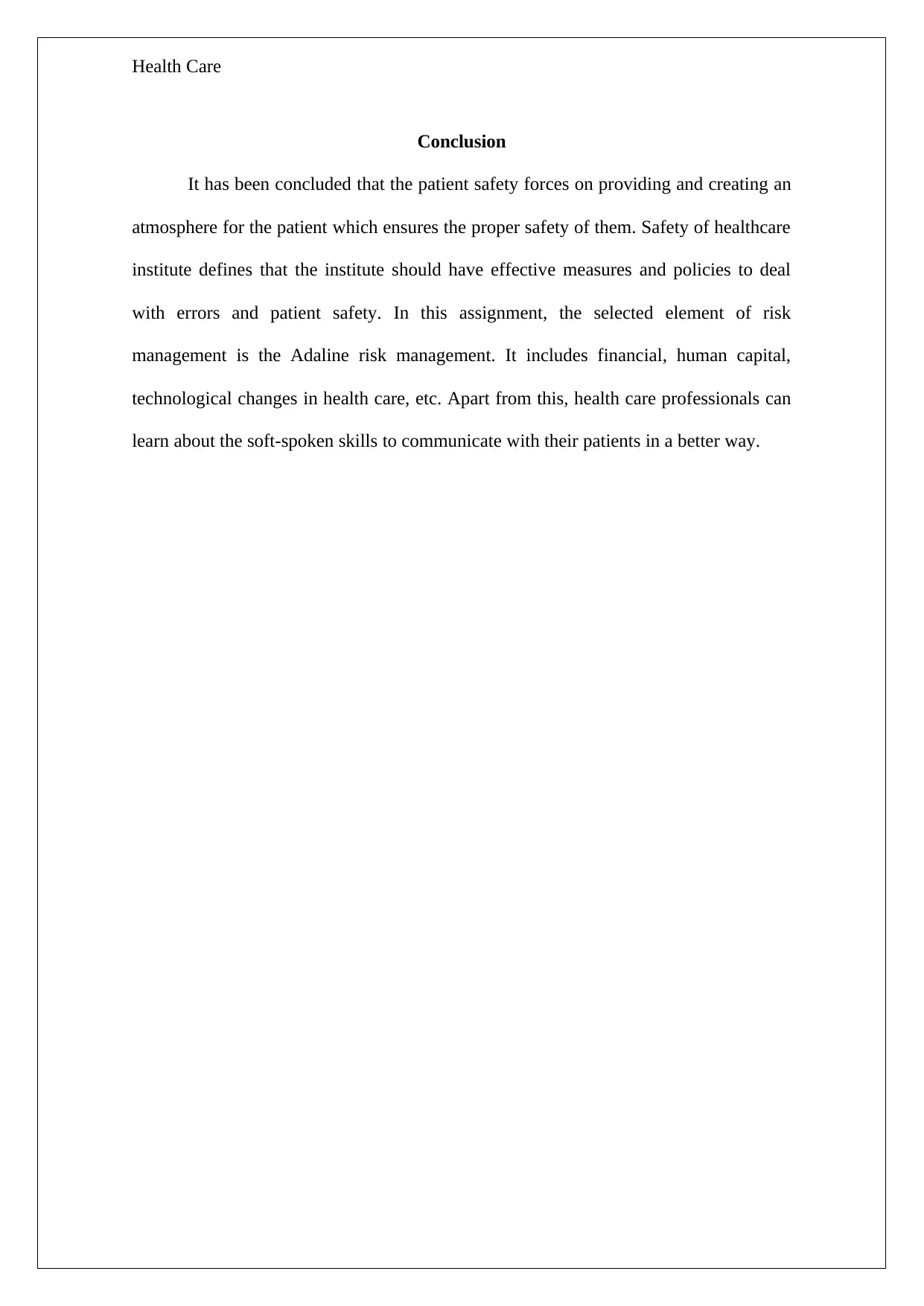
Health Care
Conclusion
It has been concluded that the patient safety forces on providing and creating an
atmosphere for the patient which ensures the proper safety of them. Safety of healthcare
institute defines that the institute should have effective measures and policies to deal
with errors and patient safety. In this assignment, the selected element of risk
management is the Adaline risk management. It includes financial, human capital,
technological changes in health care, etc. Apart from this, health care professionals can
learn about the soft-spoken skills to communicate with their patients in a better way.
Conclusion
It has been concluded that the patient safety forces on providing and creating an
atmosphere for the patient which ensures the proper safety of them. Safety of healthcare
institute defines that the institute should have effective measures and policies to deal
with errors and patient safety. In this assignment, the selected element of risk
management is the Adaline risk management. It includes financial, human capital,
technological changes in health care, etc. Apart from this, health care professionals can
learn about the soft-spoken skills to communicate with their patients in a better way.
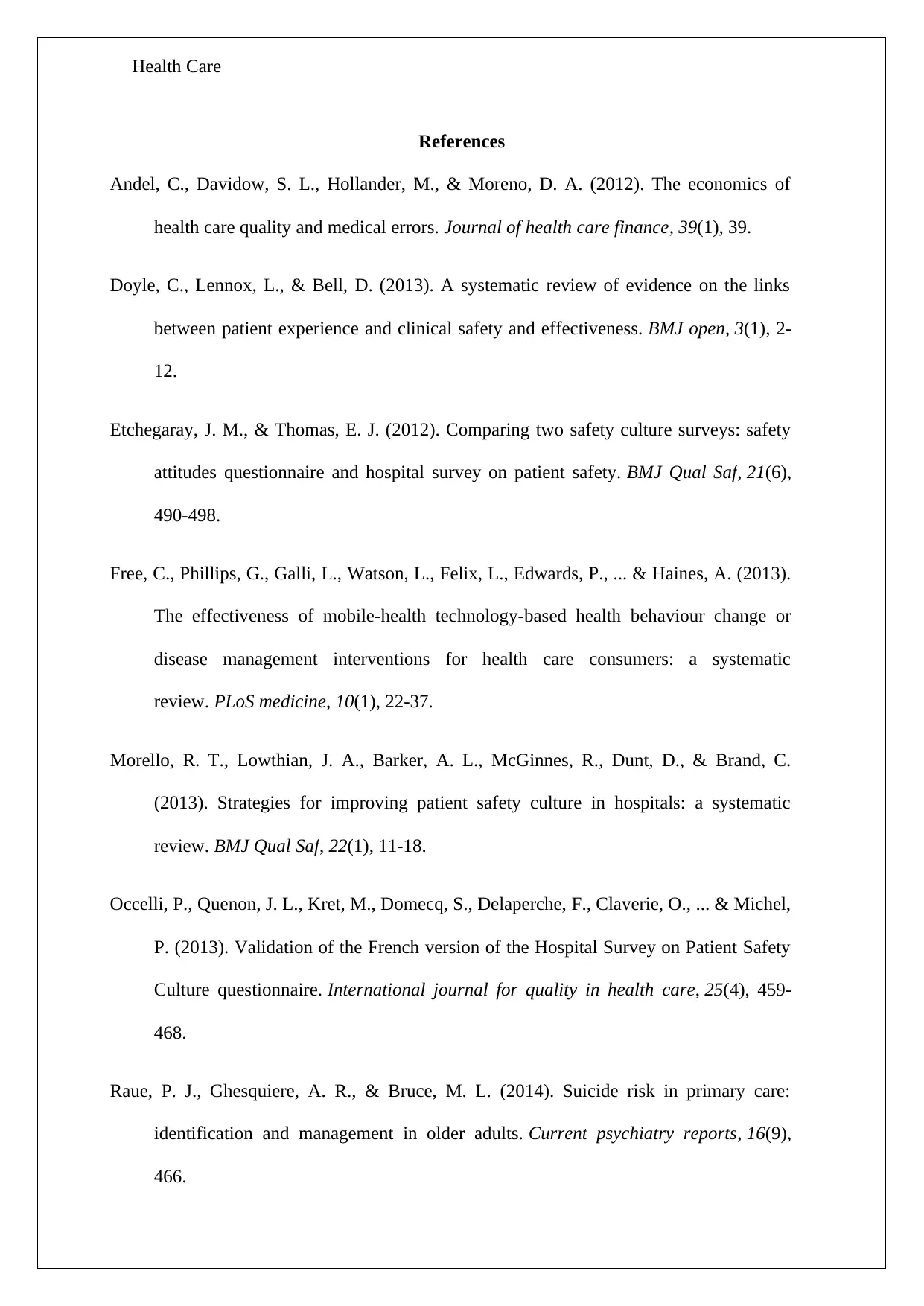
Health Care
References
Andel, C., Davidow, S. L., Hollander, M., & Moreno, D. A. (2012). The economics of
health care quality and medical errors. Journal of health care finance, 39(1), 39.
Doyle, C., Lennox, L., & Bell, D. (2013). A systematic review of evidence on the links
between patient experience and clinical safety and effectiveness. BMJ open, 3(1), 2-
12.
Etchegaray, J. M., & Thomas, E. J. (2012). Comparing two safety culture surveys: safety
attitudes questionnaire and hospital survey on patient safety. BMJ Qual Saf, 21(6),
490-498.
Free, C., Phillips, G., Galli, L., Watson, L., Felix, L., Edwards, P., ... & Haines, A. (2013).
The effectiveness of mobile-health technology-based health behaviour change or
disease management interventions for health care consumers: a systematic
review. PLoS medicine, 10(1), 22-37.
Morello, R. T., Lowthian, J. A., Barker, A. L., McGinnes, R., Dunt, D., & Brand, C.
(2013). Strategies for improving patient safety culture in hospitals: a systematic
review. BMJ Qual Saf, 22(1), 11-18.
Occelli, P., Quenon, J. L., Kret, M., Domecq, S., Delaperche, F., Claverie, O., ... & Michel,
P. (2013). Validation of the French version of the Hospital Survey on Patient Safety
Culture questionnaire. International journal for quality in health care, 25(4), 459-
468.
Raue, P. J., Ghesquiere, A. R., & Bruce, M. L. (2014). Suicide risk in primary care:
identification and management in older adults. Current psychiatry reports, 16(9),
466.
References
Andel, C., Davidow, S. L., Hollander, M., & Moreno, D. A. (2012). The economics of
health care quality and medical errors. Journal of health care finance, 39(1), 39.
Doyle, C., Lennox, L., & Bell, D. (2013). A systematic review of evidence on the links
between patient experience and clinical safety and effectiveness. BMJ open, 3(1), 2-
12.
Etchegaray, J. M., & Thomas, E. J. (2012). Comparing two safety culture surveys: safety
attitudes questionnaire and hospital survey on patient safety. BMJ Qual Saf, 21(6),
490-498.
Free, C., Phillips, G., Galli, L., Watson, L., Felix, L., Edwards, P., ... & Haines, A. (2013).
The effectiveness of mobile-health technology-based health behaviour change or
disease management interventions for health care consumers: a systematic
review. PLoS medicine, 10(1), 22-37.
Morello, R. T., Lowthian, J. A., Barker, A. L., McGinnes, R., Dunt, D., & Brand, C.
(2013). Strategies for improving patient safety culture in hospitals: a systematic
review. BMJ Qual Saf, 22(1), 11-18.
Occelli, P., Quenon, J. L., Kret, M., Domecq, S., Delaperche, F., Claverie, O., ... & Michel,
P. (2013). Validation of the French version of the Hospital Survey on Patient Safety
Culture questionnaire. International journal for quality in health care, 25(4), 459-
468.
Raue, P. J., Ghesquiere, A. R., & Bruce, M. L. (2014). Suicide risk in primary care:
identification and management in older adults. Current psychiatry reports, 16(9),
466.
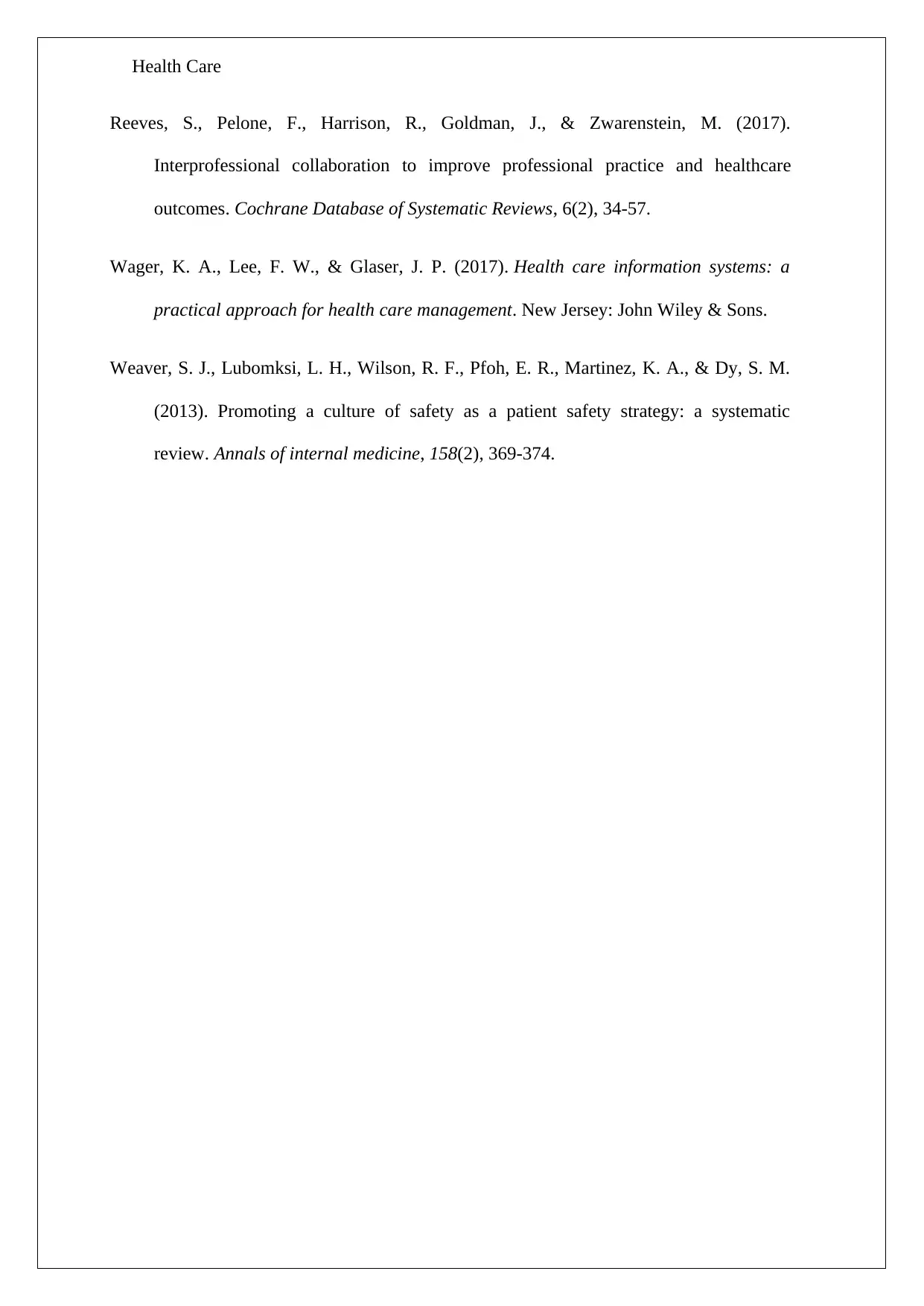
Health Care
Reeves, S., Pelone, F., Harrison, R., Goldman, J., & Zwarenstein, M. (2017).
Interprofessional collaboration to improve professional practice and healthcare
outcomes. Cochrane Database of Systematic Reviews, 6(2), 34-57.
Wager, K. A., Lee, F. W., & Glaser, J. P. (2017). Health care information systems: a
practical approach for health care management. New Jersey: John Wiley & Sons.
Weaver, S. J., Lubomksi, L. H., Wilson, R. F., Pfoh, E. R., Martinez, K. A., & Dy, S. M.
(2013). Promoting a culture of safety as a patient safety strategy: a systematic
review. Annals of internal medicine, 158(2), 369-374.
Reeves, S., Pelone, F., Harrison, R., Goldman, J., & Zwarenstein, M. (2017).
Interprofessional collaboration to improve professional practice and healthcare
outcomes. Cochrane Database of Systematic Reviews, 6(2), 34-57.
Wager, K. A., Lee, F. W., & Glaser, J. P. (2017). Health care information systems: a
practical approach for health care management. New Jersey: John Wiley & Sons.
Weaver, S. J., Lubomksi, L. H., Wilson, R. F., Pfoh, E. R., Martinez, K. A., & Dy, S. M.
(2013). Promoting a culture of safety as a patient safety strategy: a systematic
review. Annals of internal medicine, 158(2), 369-374.
1 out of 13
Related Documents
Your All-in-One AI-Powered Toolkit for Academic Success.
+13062052269
info@desklib.com
Available 24*7 on WhatsApp / Email
![[object Object]](/_next/static/media/star-bottom.7253800d.svg)
Unlock your academic potential
© 2024 | Zucol Services PVT LTD | All rights reserved.





